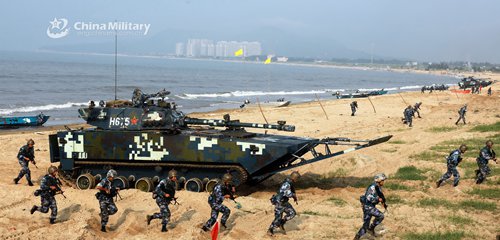December 26th, 1991 saw one of the most influential moments of the 20th century. Mikhail Gorbachev announced on Soviet TV, that he resigned his position as General Secretary of the Communist Party, and that the Soviet Union was officially dissolved. Half a century of being close to nuclear apocalypse was over. But this is earth, meaning long-lasting tranquility is never, ever in the table. And in the place of the Soviet Union of old, rose another Communist power: the People’s Republic of China.
China’s Rise
Before the 1980s, the People’s Republic of China was typically thought of as a notable, but still very much backwater nation, constrained by its communist economic policies. But a faction of reformers led by one Deng Xiaoping wanted to change that, and change it they did. In 1978, a series of economic reforms were announced by the reformist faction, and a new era in China’s history was begun. Slowly, at first, the CCP set up “special economic zones” along the coast of China, areas in which communist restrictions on private businesses were largely scrapped. Soon, however the CCP realized the gargantuan economic potential these capitalist policies could bring.
Throughout the 80’s and 90’s, the Chinese steadily introduced policies to entice foreign investors into the country, and all of a sudden, the Chinese nation’s GDP took off like a rocket. Foreign businesses and investors were chomping at the bit to gain access to the absolutely massive untapped market China provided. Companies ranging from the lowly Apple corporation to the all-powerful Kentucky Fried Chicken began massively expanding operations in China, and the country’s own manufacturing sector went into overdrive, with China becoming the “factory of the world”. But one sector in particular saw absolutely mind-boggling growth. China’s real estate sector exploded, with scores of truly gargantuan development companies springing up, and raising incredible amounts of money from investors. The real estate market has become such an integral part of China’s economy, that by 2023, a staggering 30% of China’s GDP growth was due to the real-estate market.

A challenger to the United States?
In a number of areas, various analysts have observed that China has become a serious counterbalance to the United States. But are these worries founded? And can China maintain that position?
A serious economic challenger?
Unsurprisingly, this sustained economic growth made many western observer begin to question if the “Pax Americana” of the 80’s and 90’s was coming to an end. The United States had, by far, been the greatest economic power in the world as the Soviet Union’s economy stagnated in the 1970s and subsequently imploded in the late 1980s. Perhaps the Chinese would be the undoing of all that. Their fears seemed to hold merit, as the Chinese economy just didn’t stop, and in fact accelerated, seemingly a juggernaut that just couldn’t be stopped.

COVID Chaos
And then COVID happened. The pandemic wreaked absolute havoc on every single country on the planet, the U.S. being no exception, as we, in 2023, still experience supply chain issues, and for a time, abnormally high inflation. But the U.S. is clearly on the road to better economic days, with inflation continually lowering, and supply chain issues being slowly resolved. But China seemed somewhat different.
Areas of China’s economy simply didn’t recover, and are struggling to do so even 2 years after the pandemic was popularly considered to be over. A combination of underlying issues with the structure of many Chinese companies and draconian measures regarding the “Zero-COVID Policy” seriously compromised the ability of many Chinese businesses to function. As of 2023, massive Chinese corporations such as Evergrande and Fantasia Holdings defaulted on debts, signaling a serious crisis within the Chinese real estate market.
So, it seems China, with a slowing economy and aging populous will not overtake the U.S. economically. To be clear, I am not predicting the imminent implosion of the Chinese housing market and economy as a whole. After all, a number of sectors have appeared to recover, such as manufacturing. But the point stands that China barely scraped past its GDP growth target of 5% this past year, and that growth target itself was a lot lower than previous years.

A serious military challenger?
The People’s Liberation Army, comprising the People’s Liberation Army Ground Force, the People’s Liberation Army Air Force, the People’s Liberation Army Navy, and the People’s Liberation Army Marines (because they apparently haven’t figured out how to name military branches), have undergone breakneck modernization in both doctrine and equipment. The Chinese army of the early 2000s looked almost identical to the Chinese army of the 1960s, with the same mass-charge focused doctrine, virtually the same planes, tanks, guns, even radios (when they had them). But with this newfound economic boom, the Chinese military saw a massive infusion of cash, and the 2000s Chinese Military Modernization had begun. The industrial heft of China allowed for some truly impressive progress to be made. Take the Type-96 and Type-99 main battle tanks.
Army Modernization
To analyze China’s army modernization, we can look at tank production. Why? Well, tanks are cool and I like them. Having established the completely objective lens I am writing from, here goes. China’s tank modernization has mainly consisted of two models: The Type-96 and Type-99. Combined, in the span of about 25 years, the Chinese have made around 3700 of these tanks, basically all of which are in service with China itself.
The Type-96, being the cheaper of the two, and the workhorse of the modern Chinese tank fleet, has seen around 2500 produced, with the “blingier” Type-99 having about 1200 examples. If we divide that 3700 figure by 26 (the years it has been since the Type-96 entered production), we get around 142 tanks per year. For context, let’s look at the famous M1 Abrams. Over a span of 44 years, the Abrams saw around 10,400 examples made. Subtracting the tanks in service with foreign nations, we get around 8,100 tanks produced in the US.
Dividing that by 44, we get a result of about 184 tanks made per year specifically for the U.S. military. Now, you shouldn’t need a degree in quantum physics to tell me that 184 is more than 142. But the important thing is that the difference is not very large. In my eyes at least, if a nation can come anywhere close to any category of U.S. defense production, that is impressive. Of course, these numbers are extremely loose, as the calculations are based upon rough estimates by the International Institute for Strategic Studies. But I think the numbers still say the same thing whether it’s 1200 or 1150.

Air Force Modernization
A more strategically significant area of defense than tanks is likely aircraft production. The Chinese Air Force, like its brother organizations, has undergone incredible modernization in the past decades. For the sake of brevity, we will focus on the production of 5th generation fighter aircraft here. This does not mean the older 4th gen aircraft are irrelevant, just that they may not be as emblematic of a country’s industrial strength as a whole.
The pride of China’s defense aerospace industry is the J-20 “Flying Dragon”. A large, fast, long range aircraft, the J-20 is by most accounts a worthy foe for the F-35 Lightning 2. The Chinese firm Chengdu has made around 210 J-20 aircraft for the needs of the Chinese Air Force. The US Military operates around 442 F-35s of all types in the Navy, Marine Corp, and Air Force. The US Department of Defense has stated that it plans to buy 83 new F-35s in 2024, an order that Lockheed Martin, the manufacturer, is capable of meeting with significant room for export orders.
The Chinese have, at least according to publications like The Diplomat or Military Watch Magazine, pumped up their production capabilities to around 100 aircraft per year, greater than yearly U.S. F-35 procurement, but less than the stated 156 F-35s per year Lockheed says it is churning out if you include export orders. So we can see that 5th gen fighter procurement when it comes to domestic orders is in favor of the Chinese. These numbers, again, are rough estimates and are subject to change on both sides. Chinese factories are likely scaling up production further, and Lockheed has stated that with some more resources it could likely be making 220 F-35s per year. The U.S. could divert production from export orders for domestic use. So there is always some room for error in these numbers.

Naval Buildup
The naval aspect of the Chinese military might be the most significant, seeing as there’s a little thing called the Pacific Ocean between the U.S. and China. Technically speaking, the Chinese navy has more hulls in the water than the USN. The Chinese like to brag about this, whilst conveniently ignoring that most of these hulls are glorified yachts. Okay that’s a slight exaggeration, but the point remains that the hulls that give China that distinction are tiny corvettes and missile boats.
The USN has, in 2023, no less than 11 supercarriers each holding up to 90 aircraft of different types (more on the Gerald R. Ford Class beginning to enter service). How many do the Chinese have? Well, in terms of supercarriers, none. The Chinese supercarrier Fujian has been launched, but will take a while to enter service. Apart from that, the Chinese have 2 carriers that don’t fall into the “super” category. The Shandong and Liaoning are both smaller Kuznetsov Class carriers, a Russian design from the 1980s holding only around 20 fixed-wing aircraft.
They have more limited range than their U.S. counterparts due to their lack of nuclear-powered propulsion, and the aircraft they can launch are much less capable than U.S. carrier air wings. The lack of aircraft catapults on these two mean the J-15 fighters they operate can only carry so much ordinance compared to the F/A-18 multirole aircraft aboard U.S. carriers. It appears the Chinese are in the process of rectifying this issue, with the aforementioned Fujian incoming and more carriers confirmed to be on the way. But in the meantime, the Chinese appear to have relied on a Russian style of naval warfare, with an emphasis on surface-launched missiles in the hope they can decimate U.S. carrier task forces from a long distance.
This strategy remains to be proven in combat, as no one has ever been stupid enough to launch a full-scale attack on the U.S. Navy since that one time in 1941. The missile defenses on U.S. carriers and their escorts are truly like Dante’s Inferno, so it remains to be seen how the Chinese missiles can perform. In terms of surface ships (as well as submarines), the USN has an undeniable upper-hand that the Chinese will struggle to match one-for-one. The Chinese navy would have to resort to asymmetric, defensive tactics reminiscent of the 1960s Soviet Navy if they wanted any chance of a semblance of victory.

Soft-Power Challenger?
I have talked quite a lot about hard factors, economic indicators, military production, etc. But that’s not all that matters. Perhaps the most important of these areas (and the one China might have the most success in) is what is known as “soft power”, or a nation’s ability to influence other states through means other than coercion. Hands down the most obvious example of Chinese soft power is the Belt-and-Road Initiative. It entails a massive investment in a multitude of different infrastructure projects all around the world.
Everywhere from Nicaragua to Greece has seen an influx of Chinese investment to things like roads, electrical grids, and ports. The painfully obvious goal of this plan is to grab the countries whose projects are being financed by the neck, and build a network of Chinese-reliant states across the globe. And this, I would argue, is the most threatening of all areas of Chinese influence. Some countries were already firmly in the sphere of China, such as Pakistan or North Korea.
But this initiative is clearly an attempt to expand this sphere, and challenge U.S. hegemony. Some people might say dethroning the United States would be a good thing, but those people won’t have made it this far in the article, and I don’t care what they think because they are wrong and should feel bad. Anyways, America’s response to not just the Belt and Road initiative but Chinese soft-power across the board has at times been lacking.

U.S. Failures
The Trump administration in particular, in my eyes is to blame for this. United States ambassadors to countries with strong economic ties to China like South Africa were only appointed an entire 2 years after Trump took office. Regional conferences in Asia where the U.S. would normally be present in force such as APEC 2018 instead saw limited U.S. involvement, with Xi Xinping personally being in attendance while Trump sent Vice President Pence in his place.
This conference was notable for its lack of a communique between the U.S. and China regarding their heightened economic tensions. An important part of geopolitics is showing up to things like this. Politics wasn’t exactly known for the “thrill” or “adrenaline rush” it gave you in the first place, so our leaders have no excuse not to show up to conferences such as APEC.

Conclusions
China’s rise and threat to the United States has perhaps been slightly overblown. But this does not mean we can stand idly. The Chinese posses some notable advantages that should not be ignored. In the future, I believe the U.S. must be ready to curtail the interests of this genocidal, murderous regime wherever needed. Through a combination of soft-power, military heft, a recognition of economic realities, and above all else, commitment, the U.S. is capable of stemming the tide of autocracy that is the PRC.






